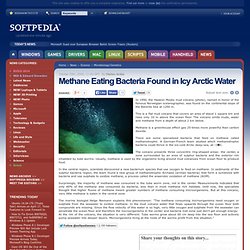

Methane-eating bacteria survive in Lost Hammer spring similar to. Published on June 5, 2010 at 6:31 AM.

Model Methanogens Provide Clues To Possible Mars Life. From universities, journals, and other organizations Date: Methane-Eating Bacteria Could Save the World - Science News. Tiny bacteria hiding out in a witches' brew of bubbling mud not only thrive in the searing-hot slurry but also chow down on its methane.

Two papers published online this week in the journal Nature describe these mud-loving microbes, the hardiest bacteria identified to date. Found living in mud volcanoes and other geothermal hideouts, the bacteria feast on methane, considered the second most abundant greenhouse gas behind carbon dioxide. • Click here to visit FOXNews.com's Natural Science Center.
While carbon dioxide makes up the majority of greenhouse gases in the atmosphere, methane traps about 20 times more heat and so is a critical global warmer. Methane Eating Bacteria Found in Icy Arctic Water - They live ar. In 1990, the Haakon Mosby mud volcano (photo), named in honor of the famous Norwegian oceanographer, was found on the continental slope of the Barents Sea at 1250 m.

This is a flat mud volcano that covers an area of about 1 square km and rises only 10 m above the ocean floor. The volcano emits muds, water and methane from a depth of about 2 km below. Methane is a greenhouse effect gas 25-times more powerful than carbon dioxide. There are some specialized bacteria that feed on methane called methanotrophic. A German-French team studied which methanotrophic bacteria could thrive in the ice-cold Arctic deep-sea, at -1C. Earth microbes may contaminate the search for life on Mars.
Bacteria common to spacecraft may be able to survive the harsh environs of Mars long enough to inadvertently contaminate Mars with terrestrial life, according to research published in the April 2010 issue of the journal Applied and Environmental Microbiology.

The search for life on Mars remains a stated goal of NASA's Mars Exploration Program and Astrobiology Institutes. Life Forms May Have Evolved In Ancient Hot Springs On Mars. Data from the Mars Reconnaissance Orbiter (MRO) suggest the discovery of ancient springs in the Vernal Crater, sites where life forms may have evolved on Mars, according to a new report. Hot springs have great astrobiological significance, as the closest relatives of many of the most ancient organisms on Earth can thrive in and around hydrothermal springs. If life forms have ever been present on Mars, hot spring deposits would be ideal locations to search for physical or chemical evidence of these organisms and could be target areas for future exploratory missions. Carlton C. Allen and Dorothy Z. Methane Doesn't Necessarily Mean Life On Mars, Says Dartmouth St.
Two Dartmouth researchers have weighed in on the debate over whether the presence of methane gas on Mars indicates life on the red planet.

Mukul Sharma, Assistant Professor of Earth Sciences, and Chris Oze, a postdoctoral fellow, argue that the Martian methane could have been produced by inorganic processes just as easily as by bacteria. In their paper published online in May in the American Geophysical Union's journal, Geophysical Research Letters, Sharma and Oze describe how methane on Mars can be made from abiotic, or non-living, sources. When water containing dissolved carbon dioxide comes in contact with olivine, it produces hydrogen, which then combines with carbon dioxide to produce methane.
Arctic Expedition Will Investigate Alien-like Glacier. A scientific expedition to a remote glacier field in Canada's High Arctic may help researchers unlock the secrets about the beginning of life and provide insights for future exploration of our solar system. A team assembled by the University of Calgary's Arctic Institute of North America plans to spend two weeks studying a sulfur-spewing spring on the surface of an ice field not far from the North Pole this summer, after it was discovered by Institute Executive Director Dr.
Benoit Beauchamp during his travels in the area. Beauchamp, U of C adjunct professor Dr. Steve Grasby from the Geological Survey of Canada, and two graduate students will conduct the first extensive study of the spring after initial tests showed the geological oddity is home to a unique form of bacteria that has adapted to thrive in a cold and sulfur-rich environment. "We really want to try and understand the plumbing system for this spring and where all this sulfur is coming from," Beauchamp said. Arctic Institute of North America (AINA) Institute - SETI Institute Homepage. David Black Selected as President and CEO at SETI Institute The SETI Institute has announced the selection of Dr.

David Black as its new President and Chief Executive Officer. Black, who is President and CEO Emeritus of the Universities Space Research Association and Visiting Scientist at the Lunar and Planetary Institute, is a widely recognized researcher in the fields of star and planet formation, and the search for exoplanets. Read More Boulder Clustering on Martian Polygonal Patterned Ground Travis Orloff (UC Santa Cruz) proposes a new mechanism for boulder clustering unique to Mars and uses observations of boulder clustering around impact features to place constraints on the timescale of boulder clustering. Read More Big Picture Science Radio Show - Since Sliced Bread Happy Birthday, World Wide Web! Axel Heiberg Island. Satellite photo montage of Axel Heilberg Island Axel Heiberg Island is an island in the Qikiqtaaluk Region, Nunavut, Canada.

Located in the Arctic Ocean, it is the 31st largest island in the world and Canada's seventh largest island. According to Statistics Canada,[1] it has an area of 43,178 km2 (16,671 sq mi). One of the larger members of the Canadian Arctic Archipelago, it is also a member of the Sverdrup Islands and Queen Elizabeth Islands. It is known for its unusual fossil forests, which date from the Eocene period. History[edit] Axel Heiberg Island has been inhabited in the past by Inuit people, but was uninhabited by the time it was named by Otto Sverdrup, who explored it in 1900-01. In 1959, scientists from McGill University explored Expedition Fiord (previously Sør Fjord or South Fiord) in central Axel Heiberg Island. WikiMiniAtlas. Axel Heiberg Island, Baffin, Unorganized, Baffin Region, Nunavut.